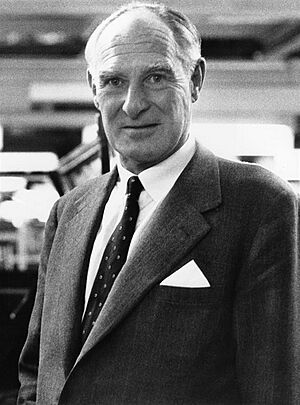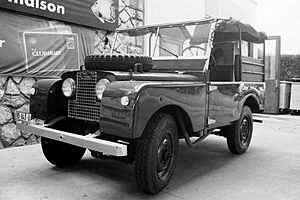Maurice Wilks facts for kids
Quick facts for kids
Maurice Wilks
|
|
|---|---|
 |
|
| Born |
Maurice Fernand Cary Wilks
19 August 1904 Eastoke, Hayling Island, Hampshire, England
|
| Died | 8 September 1963 (aged 59) Newborough, Anglesey, Wales
|
| Nationality | English |
| Known for | Car design engineer |
| Relatives | Spencer Wilks (brother) |
Maurice Fernand Cary Wilks (August 19, 1904 – September 8, 1963) was a clever English engineer. He designed cars and airplanes. By the time he passed away in 1963, he was the chairman of the Rover Company. He is most famous for creating the idea for the Land Rover. This tough vehicle was designed to be used off-road, especially by farmers.
Contents
Early Life of Maurice Wilks
Maurice Wilks was born on August 19, 1904. His birthplace was Hayling Island in England. He was the youngest of five brothers and one sister. His brother, Spencer Wilks, also became very important at the Rover Car Company. Maurice went to school at Malvern College.
Maurice Wilks' Engineering Career
Maurice Wilks started his career in 1922. He worked for the Hillman Motor Car Company in Coventry until 1926. Then, he moved to the United States to work for General Motors. After two years, he returned to England and worked for Hillman again.
Joining the Rover Company
In 1930, Maurice joined the Rover Company. He became the chief engineer. His older brother, Spencer Wilks, had already joined Rover in 1929. Spencer became the managing director of Rover in 1932. Together, the brothers decided that Rover would only make high-quality cars.
Developing Jet Engines
During World War II, Maurice Wilks led a team at Rover. They worked on developing jet engines for aircraft. These engines were based on designs by Frank Whittle. Later, in 1943, the project was given to Rolls-Royce. After the war, Maurice kept working on jet engines. Rover even showed off the first car powered by a jet engine in 1949.
The Birth of the Land Rover
After the war, Maurice Wilks was at his farm in Anglesey, Wales. He used an old army Jeep for farm work. His brother Spencer was visiting him. They had an idea to create a new, tough, four-wheel-drive vehicle. It would be perfect for farmers. They called this new vehicle the "Land Rover."
By the summer of 1947, Rover had built a test Land Rover. It was based on a Jeep frame. In September 1947, Rover decided to build 50 more models for testing. The Land Rover was officially shown to the world in 1948. This happened at the Amsterdam Motor Show.
Leadership at Rover
Maurice Wilks remained the chief engineer until 1946. He then became the technical director. In 1956, he became a joint managing director with his brother Spencer. Maurice took over as the main managing director in 1960. In 1962, he became the chairman of the Rover Company.
Later Life and Family
Maurice Wilks passed away on September 8, 1963. He was 59 years old. He died at his farm near Newborough, Anglesey. He was known for being a very smart engineer. He avoided being in the public eye. He was survived by his wife, Barbara Martin-Hurst, and their three children.
The Wilks Family and Rover
The Rover Company was like a family business for many years. This was especially true from the 1930s until it joined British Leyland.
- Maurice's older brother, Spencer Wilks, was a very important leader at Rover. He was the managing director from 1932. He became chairman in 1957. Spencer brought Maurice to Rover from Hillman.
- William Martin-Hurst was Rover's managing director later on. He was related to Maurice Wilks through marriage.
- Peter Wilks was Maurice's nephew. He took over Maurice's role as technical director in 1963. He later became the engineering director.
- Charles Spencer King was another nephew of Spencer and Maurice Wilks. He became the technical director after Peter Wilks.



